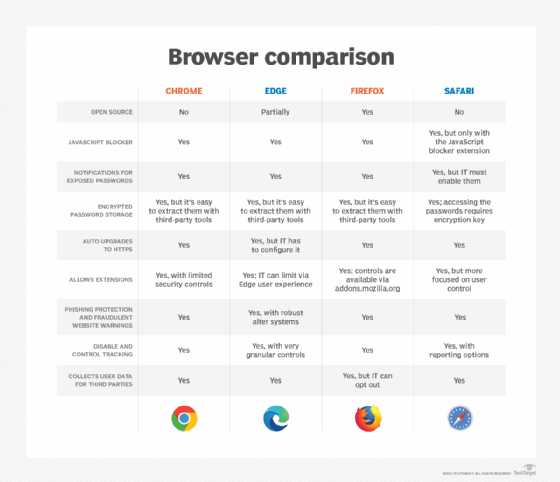Google Chrome browser
What is Google Chrome browser?
Google Chrome browser is a free web browser used for accessing the internet and running web-based applications. The Google Chrome browser is based on the Open Source Chromium web browser project. Google released Chrome in 2008 and issues several updates a year.
Google Chrome is available for Microsoft Windows, Apple macOS and Linux desktop operating systems (OSes), as well as the Android and iOS mobile operating systems. Google Chrome is the default browser for Google devices including Android phones and Chromebook laptops. It is the most used web browser, with 66% of the market as of November 2022, according to StatCounter.
Google Chrome is part of Google services, Google's family of products that includes Gmail, Google Maps and the Chrome search engine. Many of Google services are hosted on Chrome, which was one of the first internet browsers to use the cloud to support applications such as Google Docs, Google's popular word processor.

Google Chrome development history
Chrome was one the first major web browsers to combine the search box and address bar, known as the Omnibar, a feature that most competitors have since adopted. Users can sign in with their Google accounts, letting them sync bookmarks and webpages across multiple devices and access other Google products such as Google Drive.
The Google Chrome browser takes a sandboxing-based approach to web security. Each open website runs as its own process, which helps prevent malicious code on one page from affecting others or the computer OS itself. The browser supports web standards such as HTML5 and cascading style sheets.
Key events in Google Chrome's development history and among Chrome updates include the following:
- 2006. Google began developing Chrome based on open source code from the Mozilla Foundation and the Google Chromium project.
- Sept. 2, 2008. Google released a beta version of Chrome for Windows.
- Dec. 8, 2009. A beta version of Chrome was released for MacOS X and Linux.
- May 25, 2010. Google released Chrome 5.0, the first stable Chrome version that supports Windows, Mac and Linux.
- Feb. 11, 2011. Google launched the Chrome Web Store, an online marketplace where users can install free and paid browser extensions to run inside Chrome.
- 2011. Google released Chrome OS, its OS for web-based applications, on the Chrome browser.
- June 2012. The first stable version of Chrome was released for iPhone and Android mobile devices respectively.
- Aug. 22, 2017. Google released Chrome Enterprise, an enterprise version of Chrome, allowing businesses to deploy and manage it at scale across their organizations.
- April 11, 2019. Chrome Browser Cloud Management service was launched, a cloud management platform that helps administrators manage Chrome in the cloud.
Key Google Chrome features
Google Chrome offers a range of features, such as the following:
Omnibox search combines Chrome's address bar with a Google search bar, letting users search and type in a URL all in one place. The Omnibox also lets users search for text inside webpages.
Right-click to search highlighted text allows users to highlight any text on a webpage, right-click it and perform a Google search.
Password protection uses encryption to generate, store and protect user passwords. Google automatically fills in users' passwords and monitors whether any have been exposed in data breaches.
Chrome extensions, also known as Chrome apps and Google apps, are HTML and JavaScript-based programs to enable customization of the browser. Extensions include Google Dictionary, which provides definition pop-up bubbles for words on webpages, and developer tools like JSON Formatter. Chrome extensions are available on the Chrome Web Store.

Incognito mode is a safe browsing feature that lets users search the internet on Google Chrome without Google logging their browsing history, cookies, site data and information submitted in online forms. Google disables extensions in incognito by default to protect privacy, though users can manually enable them.

Syncing across devices is possible when users turn sync on in settings. This allows them to access their passwords, bookmarks, payment information and Gmail account on any device.
Dark mode lets users darken their browser windows for nighttime browsing. Chrome also lets users customize the browser with themes and colors.
Pinnable tabs and tab groups let users group important and relevant tabs together or pin them to their browser for quick access.
Picture-in-picture mode and live captions allow users to pop out videos on websites into their own separate windows and read live captions if they are hearing disabled or want to mute their volume.
Google Chrome vs. competitor browsers
Google Chrome is often compared to the competing browsers, including Apple Safari, Microsoft Edge and Mozilla Firefox, in the following categories.
Market share
The following table shows the global market share of web browsers across desktop and mobile platforms according to StatCounter as of November 2022:
| Browser | Global market share |
| Chrome | 66% |
| Safari | 19% |
| Edge | 4% |
| Firefox | 3% |
User performance
According to tests run on virtual machines, Firefox uses more random access memory (RAM) than Edge and Chrome. RAM use affects the browser and computer performance. Browsers that use more memory can slow performance and use more compute resources. However, Chrome has been found to use more RAM when multiple tabs are open than browsers like Edge.
Privacy
Google Chrome has drawn criticism for its practices concerning user privacy. For instance, critics point to its role in surveillance capitalism through the creation and marketing of prediction products based on user behavioral data. The following table shows how Google Chrome's privacy features compare to other browsers:
| Privacy measures | Chrome | Edge | Firefox | Safari |
| Provides private browsing mode | Yes | Yes | Yes | Yes |
| Blocks third-party tracking cookies by default | No | Yes | Yes | Yes |
| Blocks social trackers | No | Yes | Yes | Yes |
Security
In terms of security, Chrome stacks up well against Edge, Safari and Firefox. All four have the following features:
- cookie management
- password storage for autofilling
- browser history and cache management
- custom site blocking

Google Chrome is the most-used browser across platforms in the world. Learn how its privacy and security features stack up against its competitors.







